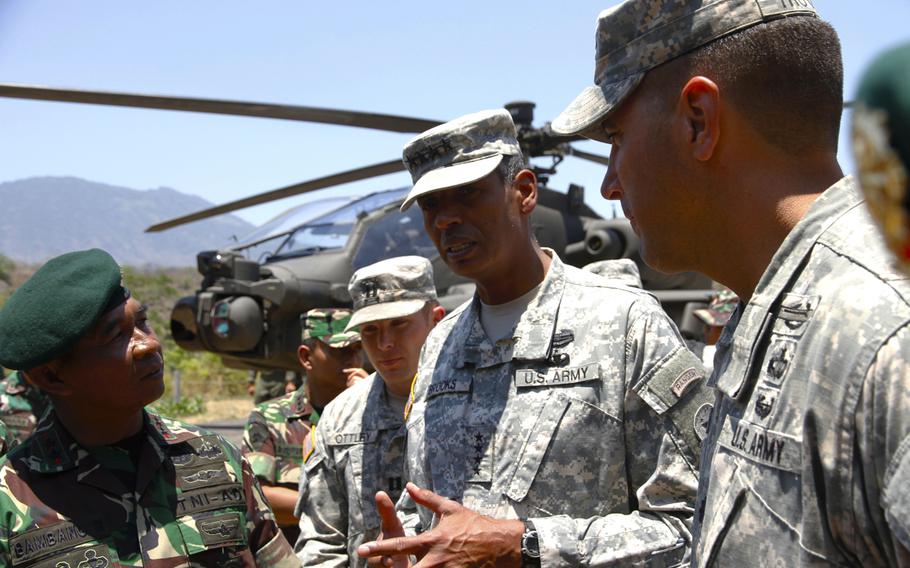
U.S. Army Pacific commander Gen. Vincent Brooks talks to Indonesian army officers about Apache attack helicopters during a tour of Garuda Shield exercise equipment on Sept. 24, 2014, on Java Island. In the background is one of four Apaches brought to Indonesia for the exercise, which is the first leg of Pacific Pathways. (Wyatt Olson/Stars and Stripes)
PUSLATPUR MARINE BASE, Indonesia — If U.S. Army Pacific wanted a place with few distractions to kick off its new concept for expeditionary-style forward deployment in Asia, this remote base on the east end of Java Island fits the bill.
The nearest urban area is hours away — on a narrow highway made treacherous by motorbikes, horse-drawn carts, lumbering trucks and precarious road shoulders. The base’s dusty scrub-tree terrain, ideal for live-fire training, spans mile after empty mile beside a looming volcanic crater wall spitting out embers that glow red in the night.
Yet aside from some grumbling about sunbaked tent life and monotonous meals, many of the soldiers involved in this year’s Garuda Shield exercise have developed a hearty camaraderie with their Indonesian counterparts during USARPAC’s inaugural Pacific Pathways engagement. For more than a month, soldiers from Joint Base Lewis-McChord in Washington and Schofield Barracks in Hawaii have been training with an infantry battalion of the host nation’s army, the Tentara Nasional Indonesia, or TNI.
“When we talk about the future of the Army, this is a microcosm of where our force is trying to go,” said Lt. Col. Michael Trotter, commander of 2nd Battalion, 1st Infantry Regiment, from Lewis-McChord.
Under Pacific Pathways, the Army will continuously develop small units to remain forward deployed for a series of already established annual exercises. During this initial Pathways, elements from Lewis-McChord and Schofield, which include Stryker fighting vehicles as well as Black Hawk and Apache helicopters, split up for simultaneous exercises – Keris Strike in Malaysia and Garuda Shield in Indonesia. In October they will join forces for the Orient Shield exercise in Japan.
Pathways is the U.S. Army’s conduit to developing a semi-permanent presence in the region, aside from the large force stationed in South Korea. While it’s not politically or financially feasible to outright establish permanent basing in “partner” countries — for example in Indonesia, Malaysia, Thailand or the Philippines — extended exercises are generally welcomed by host nations as a chance to learn from a highly professional force and glimpse advanced equipment.
From a larger perspective, Pathways is part of the Obama administration’s rebalance to the Pacific, which was intended to reinvigorate America’s diplomatic, economic and military influence in the region.
“You are the very best evidence of what it means for the United States to have strategically rebalanced its focus in this critically important Indo-Asia Pacific region,” USARPAC commander Gen. Vincent Brooks said to the assembled soldiers of both countries during a tour of the base on Wednesday. “We are essentially the military portion of the policy implemented for the Pacific rebalancing, if you will. This part in Indonesia is just one small piece of it.”
The challenge with implementing Pacific Pathways, Trotter said, is in developing the “expeditionary mindset” and addressing “things that have potentially atrophied over the last 13 years or so in the Iraq and Afghanistan fights.”
“How do we go back to our core competencies and fundamentals?” Trotter asked rhetorically. “We’re rediscovering some of those things coming into this country and working with our TNI partners, something that we have not done before – at least in our formation.”
Trotter emphasized that the Army did not have a specific “training path” for exercises in Indonesia and Malaysia. This is a major shift away from how the Army Forces Generation model had used fairly scripted training for soldiers deploying to Afghanistan and Iraq, which even tailored training down to a specific locale, he said.
“Coming out of Iraq and Afghanistan as we have, as we rebalance the Army and transform the Army, our training path was going back to our core competencies and fundamentals – regardless of where we were going to be stationed or regardless of where we were going to be deployed.”
Soldiers heading to Indonesia and Malaysia did, however, undergo “deep-dive” training, everything from language and history to weapons systems and rank structure in the host countries, he said.
Whether for those reasons or the seclusion of Puslatpur Marine Base – which was even far-flung for the TNI troops — many soldiers say they’ve developed a strong bond with their TNI counterparts.
“They train together. They live together. They eat together,” said Sgt. First Class Charles Moore of the 25th Infantry.
“We did a 20-kilometer foot march together, us and them, amongst each other’s ranks, walking together. Everything we do is together.”
Soldiers from the two countries can often be seen and heard running together for morning PT, during which the Indonesian soldiers keep the pack moving with lilting chants.
“We’ve actually been working together on a chant,” said Sgt. First Class Patrick O’Brien of the 1st Infantry. It’s a short chant that combines English and Bahasa, the dominant language in the country.
“It’s pretty exciting. Their chant, I’m told, is to bring them together and motivate them, saying, ‘We’re an army. We’re an army of one.’
“Ours together has been all about being soldiers and doing the mission together.”